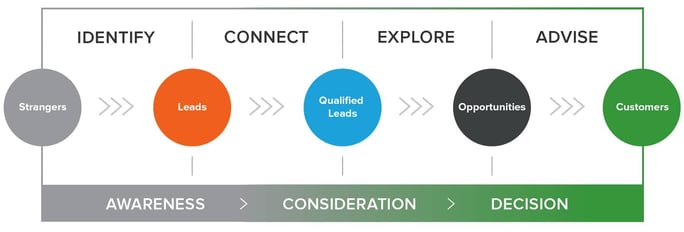In short - inbound marketing will count for little if your efforts don’t convert to sales. For sure, inbound marketing can help generate leads, build an audience, raise your profile and extend your reach but, ultimately, without a strategy for sustainable sales growth, you are likely to end up focusing on the cost of doing inbound rather than the revenue generated from it.
Problems surface if your sales team are not bought-in on the inbound methodology. And where there has been a historical misalignment between Sales and Marketing (curiously common considering both functions are part of the ‘revenue department’), this can exacerbate the issue.
So, if you are taking a closer look at how inbound marketing could reverse your fortunes, be sure to consider how you are going to involve the sales team from the outset.
The way things used to be
Previously, many B2B companies adopted a ‘sales first’ approach with marketing in a support function. But today, if you’re wed to this view, you’re likely facing falling sales forecasts as, increasingly, your sales team become less efficient.
The reasons why have been well aired.
As technology has changed, so too have the ways people communicate with each other, where they get information, how they watch TV, answer their phones (or not), get their news, or even read their books.
Change, it would seem, is a constant.
So if you are not the one providing the information your customers are looking for, there are others who soon will be.
Fundamental change in the way we buy things
Many companies are now taking a ‘marketing first’ approach. They now know the need to get found when and where people are looking for what they do, and they realise Sales, as a one-on-one function, cannot fulfil that need.
That is not to say, however, that Sales becomes more of a support function - far from it.
Rather, Sales and Marketing need to work much more closely together. The two are intrinsically linked. They are, after all, both a part of the same buying cycle, for the same client, with the same needs, pain points, frustrations and goals.
However, where one hands over to the other, the transition needs to be seamless. After all, for the buyer, this is ‘an experience’, and it needs to work end-to-end. Any disconnect in the middle is unlikely to end well.
This is where the danger lies if you do not have a joined-up (sales and marketing) approach. The world is littered with examples of fantastic experiences that start so well but, due to failings in marketing automation or a disconnect with Sales, end with disappointment (all round).
This is an opportunity!
You can choose to view everything as an end-to-end process through marketing to sales to customer service and view every prospect as a human being (not a number/lead/sale).
But viewing each person in this way requires a commitment to ‘the experience’.
It compels your salespeople to prioritise buyer’s needs before their own. It requires that they understand the context of a prospect's experience of connecting with you and that they continue to respond to the prospect's agenda first – not their own.
A fundamental difference between traditional Sales and Inbound Sales is the notion that you should always be helping – not always be closing.
An inbound salesperson will focus on understanding what the person is looking to solve and where they might be struggling. They will want to know if their solution could be a good fit for this person based on information from that contact, rather than focus instead on selling the features and benefits of their product or service.
Developing the inbound sales process
Inbound sales are built around the buyer’s journey; through the Awareness stage, the Consideration stage and the Decision stage. Unlike legacy sales with a ‘sales-first’ approach, inbound sales support the buyer through the different stages of the buyer’s journey cognisant of where they are and what they are looking for. In this way, the salesperson and the customer feel aligned, reducing friction and improving the experience for the buyer.
This is why the alignment between Marketing and Sales is so important. The job of marketing is to generate traffic and help identify leads in the Awareness stage and, as is appropriate for your type of business, begin the process of nurturing them towards the Consideration stage.

Identify: In the ‘Identify’ stage they will be unaware of who is active in the buyer’s journey. And unlike a legacy salesperson who will make a call if they think the buyer is a good fit, the inbound rep will appreciate the difference between an active and a passive buyer and focus their efforts accordingly. They will also be very focused on the ‘ideal buyer profile’ and be alert to clues as to where they should concentrate their efforts in this regard too.
Connect: The inbound salesperson will look for opportunities to ‘Connect’ to help buyers better understand if they can contribute to prioritise the challenge or goal the buyer appears to be interested in. They won’t reach out with a ‘pitch’. They are more likely to share content (permissions intact through the original conversion) that relates to the buyer’s context (like blogs, webinars, eBooks, etc.).
They will likely look for opportunities to engage through social media, and they may offer a consultation. Having reached out in this way, and dependent on the level of engagement, they may then choose to connect more directly. Assuming the buyer welcomes this non-invasive and helpful approach and decides to further explore their options, the inbound salesperson will further explore with the contact whether their offering is likely to be a good fit for them.
Explore: This stage requires a deeper dive into the context of the buyer’s interest. This is a process at the heart of the Consideration stage and is likely to be a telephone conversation, quite possibly supported by key pieces of content as follow up.
An inbound salesperson understands that they simply don’t have enough information to ‘present’ a solution at this stage. Nor is it likely that they have built trust and rapport with the buyer yet. In all probability, they are unlikely actually to know that they have an ideal solution for the purchaser as yet.
A good inbound salesperson, through strategic questioning around goals and desired outcomes, will be better able to assess the fit and help the buyer reach their own conclusions in this regard. During this process, they would also aim to understand the customer's plans, timelines, budget and authority, but this would assume they were demonstrating all of the previously mentioned attributes.
Advise: Based on information and context gathered during the Connect and Explore stages, the inbound salesperson will tailor a presentation based on the knowledge and acknowledgement that the buyer wants and needs their help and that the solution they offer is indeed a good fit.
In approaching and adapting a presentation to cater for the particular interests and needs of each qualified buyer, the inbound salesperson will create value, relevance and a meaningful experience way beyond what would otherwise be the generic one-size-fits-all presentation of the legacy rep.
In a world where everything from a sales and marketing perspective has changed, and power has shifted from seller to buyer, it is more important than ever to adjust to the new ways of connecting and helping customers rather than interrupting and closing them.


